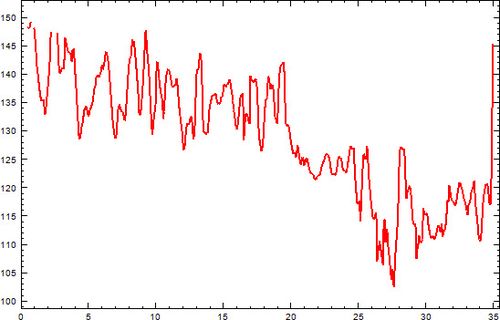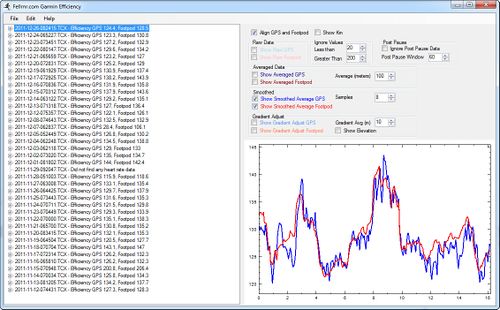Relative Running Economy
Contents
1 Introduction
There are two components to running ability; fitness and economy. Fitness is the ability of our bodies to generate energy for running and is the focus of a lot of our training. Economy is how far and fast you can run with a given amount of energy. Good economy is a critical part of running, and Cadence is one element I focus on.
2 Measuring Efficiency
In an ideal world, we’d be able to easily measure our Running Economy and see if things are improving. If we could measure our breath, find out how much O2 we consumed and how much CO2 we produce, we’d know how much energy we burned (and from fat or carbohydrate). Sadly, this is not practical, so the best measure we have of energy consumption is our heart rate. This is far from perfect, as heart rate can vary for other reasons besides supplying O2 for energy production. However, I believe it is a useful approximation.
3 How to use the efficiency value
The calculated efficiency value cannot easily be used to compare different runners. It can be used as to track how your running efficiency is improving over time. Over the weeks and months of training your efficiency value should gradually improve. For instance, I've seen my efficiency go from 110-120 to 130-150 over a period of a few months. Sadly, I've also seen my efficiency dropped when I put on body fat (see Weight Loss and Performance.) This evaluation of my fitness this proved to be remarkably useful to me.
3.1 Efficiency and Glycogen Depletion
Another use for the efficiency value is to compare values within a run. Glycogen depletion will result in a drop in efficiency, and this can be seen in the efficiency value. The graph below shows my efficiency value during a long run, consisting of pacing a 3 hour marathon, then adding on 9 extra miles at a slower pace. You can see my efficiency value staying reasonably constant, with some variation for the hills, until about mile 19. From 19 to 26 you can see my efficiency value gradually dropping due to glycogen depletion. After the marathon distance you can see some recovery as I refuel somewhat.
3.2 The Calculator
Assuming you know the distance you ran, your average heart rate and the time it took, you can calculate your efficiency. If you know your resting heart rate, enter that as well to optimize the calculation.
3.3 The Garmin Utility
If you have a Garmin GPS, this utility will analyze the TCX files to calculate efficiency.
You can download it from http://fellrnr.com//Utilities/GarminEfficiency/GarminEfficiency.exe. Look for the tooltips that pop up when you hover over an option; they'll provide some help.
3.4 The Efficiency Calculation
The formula that is used is
Total Beats = (Average Heart Rate – Resting Heart Rate) * Time in Minutes
Work Per Mile = Total Beats / Distance in Miles
Efficiency = 1 / Work Per Mile * 100,000
3.5 A more impressive alternative
Alternative Efficiency Calculator uses age, gender, and weight to calculate Calories consumed, and therefore the absolute efficiency. While this is more impressive and allows for comparison between runners, it makes quite a few assumptions in the calculations. If you know your VO2max, this calculation becomes somewhat more accurate, but should still be considered only a rough approximation.


